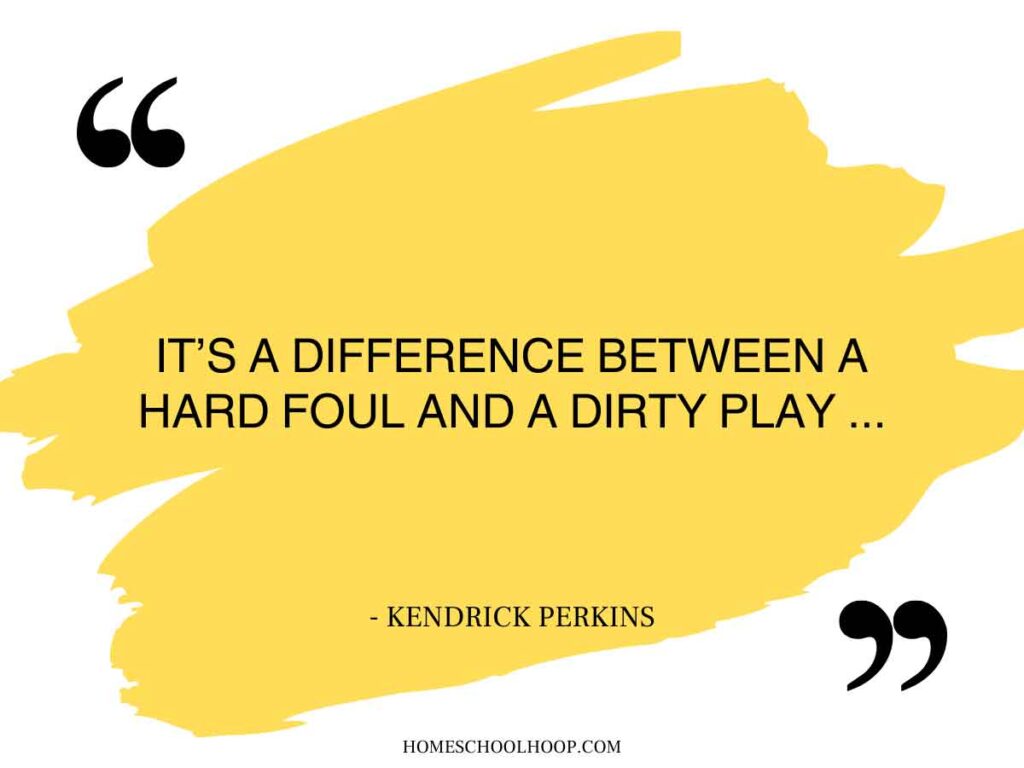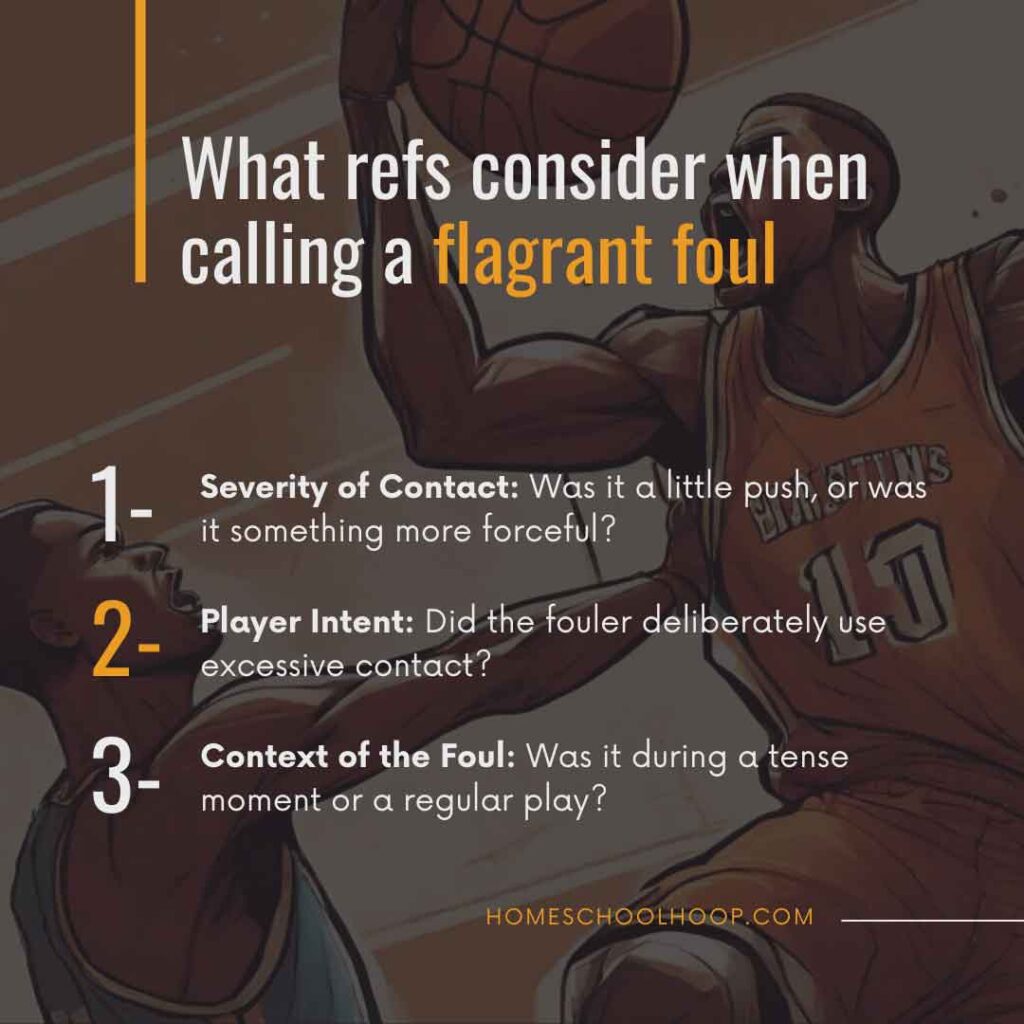Sometimes, in the heated moments of a basketball game, players might commit what’s known as a flagrant foul. This isn’t just a regular illegal contact foul; it’s a big deal. Flagrant fouls are serious because they involve rough or overly aggressive actions. They can change how the game turns out and can lead to serious penalties.
Key Takeaways:
- A flagrant foul in basketball is when a player makes a very rough or violent move against another player.
- There are two types of these fouls: Flagrant 1 and Flagrant 2. Each type has different outcomes and penalties.
- Flagrant fouls are different from technical fouls. Technical fouls are for bad behavior or not following the rules, but they don’t involve physically rough play like flagrant fouls do.
In this article, we’ll explain everything you need to know about flagrant fouls. You’ll learn about the different types, what makes a foul ‘flagrant,’ and what happens when one is called.
What is a Flagrant Foul?
In basketball, a flagrant foul is one of the most serious fouls a player can commit. Unlike a regular personal foul that happens during a game, flagrant fouls are more severe. They involve actions that are unnecessary and too rough or aggressive to be part of fair play, and they can happen during both live play and during dead ball situations.
All leagues take flagrant fouls seriously because they compromise player safety. Let’s look at how the NBA, WNBA, and NCAA define these flagrant fouls.

NBA’s Definition of a Flagrant Foul
In the NBA, a flagrant foul is called when a player’s contact with another is unnecessary or excessively forceful. There are two types:
- Flagrant 1: This is for unnecessary contact.
- Flagrant 2: This is for contact that is both unnecessary and excessive, meaning it’s more severe than Flagrant 1.
Both Flagrant 1 and Flagrant 2 are taken very seriously in the NBA. They can result in penalties like free throws for the other team and, potentially, the ejection of the player who committed the foul.
For example, as they battled for a rebound, Vince Carter of the Dallas Mavericks once responded to contact by Steven Adams of the Oklahoma City Thunder with a retaliation elbow, demonstrating a flagrant foul situation.
WNBA’s Approach to Flagrant Fouls
The WNBA follows rules similar to the NBA for flagrant fouls, categorizing them into Flagrant 1 and Flagrant 2 based on how severe the contact is.
In a WNBA example, A’ja Wilson of the Las Vegas Aces was called for a Flagrant 1 foul against Layshia Clarendon of the Los Angeles Sparks while setting a screen (although there’s a bit of flopping by Clarendon here), showcasing a situation where excessive contact occurred.
Learn more: Top 10 A’ja Wilson Shirts
NCAA’s Perspective on Flagrant Fouls
In NCAA men’s basketball, flagrant fouls are classified as follows:
- Flagrant 1: This is for excessive or severe contact during the game.
- Flagrant 2: This is more serious, for extremely unsportsmanlike conduct or severe contact when play is stopped. Fighting is also a flagrant 2 foul.
In NCAA women’s basketball, the terms are slightly different. Rather than use the term “flagrant,” they use “unsportsmanlike” for Flagrant 1-type fouls and “disqualifying” for Flagrant 2-type fouls. But the meaning is similar, focusing on the severity and nature of the foul.
Flagrant 1 vs. Flagrant 2 Fouls
While both Flagrant 1 and Flagrant 2 fouls are serious, the level of severity and the penalties involved differ.
| SEVERITY OF CONTACT | PENALTIES | |
| Flagrant 1 | Unnecessary but not extremely rough. | Free throws for the opposing team and ball possession. |
| Flagrant 2 | Unnecessary and extremely rough. | Ejection of the offending player, free throws, and ball possession for the opposing team. |
What is a Flagrant 1 Foul?
- Definition: A Flagrant 1 foul is called for unnecessary contact. This means the player made contact with an opponent in a way that is not needed for normal play.
- Examples: Elbowing someone while trying to protect the ball or making hard contact with an opponent while trying to block a shot.
- Penalties: The penalties for a Flagrant 1 foul usually include free throws for the other team and the ball possession after the free throws.
This flagrant foul by Kahleah Copper of the Chicago Sky was deemed a Flagrant 1 since the contact wasn’t excessive.
What is a Flagrant 2 Foul?
- Definition: A Flagrant 2 foul is more severe. It’s called for contact that is both unnecessary and excessive.
- Examples: Striking an opponent with an elbow in a harmful way, or a very rough push that could injure the player.
- Penalties: Flagrant 2 fouls often result in the player who committed the foul being ejected from the game. The other team gets free throws and the ball.
In this example, when a Clemson player deliberately barrels into Wendell Moore of Duke University while he’s in the air for a dunk. With this intentional foul, he’s given a Flagrant 2 foul.
TRIVIA:
Can you name the all-time flagrant foul leader in the NBA?
Clue 1: This player is known for his physical defensive play at center and was active in the NBA during the mid-2000s through 2022.
Clue 2: He played for several teams but is most associated with his first team, the Orlando Magic.
Clue 3: He was a central figure in the controversy around the NBA’s 75th anniversary list when he was left off.
Scroll to the bottom for the answer.
The Criteria for Determining a Flagrant Foul
When a referee calls a flagrant foul in a basketball game, they consider several important factors. These criteria help them decide whether a foul is flagrant and, if so, whether it’s a Flagrant 1 or Flagrant 2.

1. Severity of Contact
- How Strong Was the Contact? The first thing a referee looks at is how severe the contact was. Was it a little push, or was it something more forceful?
- Physical Safety: Referees consider whether the action could have hurt the other player. Safety is a top priority.
2. Intent of the Player
- Did They Mean It? Referees try to figure out if the player meant to commit the foul or if it was an accident.
- Looking at the Action: They watch how the player moves. Was the movement natural during play, or did it seem deliberate?
3. Context of the Foul
- When and Where: The timing and location of the foul matter. Was it during a tense moment or a regular play?
- Game Situation: Referees also consider what’s happening in the game. Is it a close game? Are players getting frustrated?
In short, referees decide flagrant fouls based on the severity, intent, and context of the foul. They will often watch instant replay to see exactly what happened. They also discuss with each other to get different viewpoints.
Flagrant Fouls vs. Technical Fouls
Flagrant fouls are often confused with technical fouls in basketball. Both can impact the game, but they differ in nature and consequences.
| FLAGRANT FOULS | TECHNICAL FOULS | |
| Physical Contact | Involve physical contact. | Don’t involve physical contact. |
| Reason for the Foul | Excessive or aggressive physical contact. | Behavior-related, like arguing or disobeying game rules. |
| Penalties | Can lead to ejection, free throws, and ball possession. | Usually results in free throws and ball possession, multiple can lead to ejection. |
While flagrant fouls involve excessive physical contact, technical fouls are violations of game conduct. They don’t involve physical contact with other players. A technical foul is given for unsportsmanlike behavior, like arguing with referees or taunting opponents.
Both lead to free throws and ball possession for the fouled team. However, a single Flagrant 2 foul can lead to ejection, whereas a player must receive two technical fouls to be removed from the game.
Strategies to Avoid Flagrant Fouls
Nothing positive comes from flagrant fouls. They give opponents free scoring opportunities, and more ball possessions, and potentially impact the available roster. Here are some tips for players to avoid committing flagrant fouls, focusing on discipline and awareness.
- Stay Calm: In high-pressure moments, keep your cool. Practice calmness and focus, even when the game gets intense. Learn to manage emotions during the game. Deep breathing or focusing on the next play can help.
- Be Game-Aware: Understand what makes a foul flagrant so you’re less likely to break the game rules. Also, stay alert to how the game is unfolding to prevent overreactions.
- Practice Safe Movements: Learn and practice moves that are effective but not overly aggressive. This will help you recognize when a play is too risky.
- Build Team Unity: Talking with teammates during the game helps avoid misunderstandings and quick, ill-considered actions. A stronger unit will also help keep teammates in check.
- Reflect After Games: Once a game is over, look at any aggressive fouls you committed. Understanding what and why something went wrong will help you improve.
FAQs on Flagrant Fouls
What is the difference between a Flagrant 1 and Flagrant 2 foul?
A Flagrant 1 foul is called for unnecessary contact, while a Flagrant 2 foul is for contact that is both unnecessary and excessively rough. Flagrant 2 is more severe and often leads to the player’s ejection from the game.
How do referees decide if a foul is flagrant?
Referees consider the severity of the contact, the intent behind it, and the context in which it occurred. They often review replays before making the final call.
Can a flagrant foul result in suspension or ejection?
Yes, a Flagrant 2 foul usually results in the player’s immediate ejection from the game. Repeated flagrant fouls across games can lead to a player’s suspension.
What is the difference between a flagrant foul and a technical foul?
A flagrant foul involves physical contact that is unnecessary or excessively rough. A technical foul is given for unsportsmanlike behavior or conduct, not involving physical contact.
What warrants a flagrant foul?
A flagrant foul is warranted when a player makes unnecessary and/or excessively rough physical contact with an opponent.
How many flagrant fouls before ejection?
In most cases, two Flagrant 1 fouls or one Flagrant 2 foul will result in a player’s ejection from the game.
What is a flagrant foul in the NBA?
In the NBA, a flagrant foul is a serious offense marked by unnecessary and/or excessively rough contact. It’s divided into Flagrant 1 (unnecessary contact) and Flagrant 2 (unnecessary and excessive contact).
LET US KNOW
Today, you learned about the flagrant foul in basketball.
So we want to know: In your opinion, what has been the most memorable flagrant foul in basketball history?
Let us know about the incident and why it stands out to you in the comments.
The TRIVIA answer is Dwight Howard with a record-high 22 flagrant fouls.


